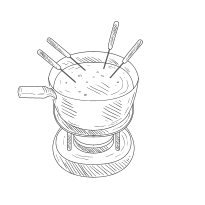What is Oil Fondue?
Oil fondue, a communal dining experience originating in Switzerland,
offers a fun and interactive way to enjoy a meal with friends and
family. Unlike cheese fondue, where ingredients are dipped into a
shared pot of melted cheese, oil fondue involves spearing bite-sized
pieces of food onto long-stemmed forks and cooking them in a
communal pot of hot oil.
The Allure of Oil Fondue
Oil fondue’s appeal lies in its versatility and entertainment
value. The ability to cook a variety of ingredients, from meats and
seafood to vegetables and bread, makes it a crowd-pleasing option
for gatherings. The act of cooking your own food at the table adds
an element of engagement and interactivity, fostering conversation
and laughter. Moreover, the communal aspect of sharing a pot of
hot oil and dipping sauces creates a warm and convivial atmosphere.
Essential Equipment for Oil Fondue
Before embarking on your oil fondue adventure, gather the
necessary equipment:
1. Fondue Pot
A fondue pot, also known as a caquelon, is indispensable. Opt for
a pot made of stainless steel, cast iron, or ceramic, as these
materials distribute heat evenly and can withstand high
temperatures. The pot should have a wide, flat base for stability
and a sturdy stand to elevate it above the heat source.
2. Heat Source
Maintaining a consistent oil temperature is crucial for successful
oil fondue. A dedicated fondue burner, fueled by gel paste or
liquid fuel, offers precise heat control and is the preferred
choice. Alternatively, a portable electric burner can be used,
but ensure it provides sufficient heat output.
3. Fondue Forks
Specialized fondue forks with long, heat-resistant handles are
essential for safely dipping and retrieving food from the hot
oil. Choose forks with different colored handles to prevent mix-ups
among diners.
4. Other Essential Tools
In addition to the primary equipment, gather the following:
- Slotted spoon: For removing cooked food from the oil.
-
Splatter guard: To minimize oil splatters and protect your
table. -
Small plates or bowls: For holding dipping sauces and cooked
food. -
Cutting board and sharp knife: For preparing the fondue
ingredients.
Choosing the Right Oil for Fondue
Selecting the appropriate oil is paramount for a successful oil
fondue experience. The ideal oil should have a high smoke point,
meaning it can withstand high temperatures without breaking down
and releasing harmful compounds. Avoid oils with strong flavors
that could overpower the taste of the fondue ingredients.
Recommended Oils for Oil Fondue
- Peanut oil: A popular choice due to its high smoke point and neutral flavor.
- Canola oil: Another neutral-tasting oil with a high smoke point.
- Safflower oil: Known for its very high smoke point and mild flavor.
- Sunflower oil: Similar to safflower oil in terms of smoke point and flavor.
- Grapeseed oil: A lighter oil with a slightly nutty flavor and a high smoke point.
Oils to Avoid
Refrain from using oils with low smoke points, such as:
- Olive oil: Its distinctive flavor can be overpowering, and it has a lower smoke point.
- Butter or margarine: They burn easily at high temperatures.
Preparing the Fondue Ingredients
One of the joys of oil fondue lies in the versatility of
ingredients you can cook. Here are some popular options:
1. Meats
- Beef: Tender cuts like sirloin, tenderloin, or filet mignon, cut into bite-sized cubes.
- Chicken: Boneless, skinless breasts or thighs, cut into small pieces.
- Lamb: Tender cuts like loin or leg, diced into cubes.
- Pork: Tenderloin or boneless chops, cut into small pieces.
2. Seafood
- Shrimp: Peeled and deveined, leaving the tails on for dipping.
- Scallops: Halved or quartered if large.
- Firm white fish: Cut into bite-sized pieces.
3. Vegetables
- Broccoli: Cut into small florets.
- Cauliflower: Cut into small florets.
- Mushrooms: Button, cremini, or shiitake, whole or halved if large.
- Zucchini: Cut into thin rounds or sticks.
- Bell peppers: Cut into bite-sized pieces.
4. Other
- Potatoes: Small, waxy potatoes, parboiled until slightly tender.
- Bread: Cubed crusty bread, such as baguette or sourdough.
- Tofu: Cut into cubes and pressed to remove excess water.
Making the Dipping Sauces
Dipping sauces are an integral part of the oil fondue experience,
adding flavor and enhancing the taste of the cooked
ingredients. Offer a variety of sauces to complement the different
flavors:
1. Creamy Sauces
- Horseradish sauce: Tangy and creamy, perfect for beef and potatoes.
- Garlic aioli: Rich and garlicky, complements seafood and vegetables.
- Honey mustard sauce: Sweet and tangy, pairs well with chicken and vegetables.
2. Tangy Sauces
- Barbecue sauce: Smoky and sweet, ideal for chicken, pork, and vegetables.
- Sweet chili sauce: Spicy and tangy, complements chicken and shrimp.
- Blue cheese dressing: Sharp and creamy, pairs well with beef and vegetables.
3. Other Sauces
- Teriyaki sauce: Savory and sweet, enhances chicken, beef, and vegetables.
- Peanut sauce: Creamy and nutty, complements chicken, shrimp, and vegetables.
- Curry sauce: Aromatic and flavorful, pairs well with chicken, lamb, and vegetables.
Step-by-Step Guide to Making Oil Fondue
Now that you have all the necessary equipment, ingredients, and
dipping sauces, follow these steps for a memorable oil fondue
experience:
1. Prepare the Fondue Pot and Oil
Place the fondue pot on a sturdy surface and fill it with the
chosen oil, leaving about 2-3 inches of space at the top to
prevent overflowing. Heat the oil over medium heat until it
reaches 350-375°F (175-190°C). You can use a deep-fry or candy
thermometer to monitor the temperature.
2. Prepare the Ingredients
While the oil is heating, prepare the fondue ingredients. Cut the
meats, seafood, and vegetables into bite-sized pieces, ensuring
they are small enough to cook through quickly and evenly. Pat the
ingredients dry to prevent excess splattering when they hit the
hot oil.
3. Arrange the Ingredients and Sauces
Arrange the prepared ingredients on platters or in bowls, making
sure to keep raw meats and seafood separate to prevent cross-contamination. Place the dipping sauces in small bowls or ramekins and arrange them around the fondue pot within easy reach of all diners.
4. Start Cooking and Enjoy
Once the oil reaches the desired temperature, it’s time to start cooking. Each diner can spear a piece of food onto a fondue fork and carefully lower it into the hot oil. The cooking time will vary depending on the ingredient and the size of the pieces, but most items will cook within a few minutes. Be careful not to overcrowd the pot, as this can lower the oil temperature and result in greasy food.
5. Serve and Enjoy
Once the food is cooked to your liking, carefully remove it from the oil using a slotted spoon and place it on your plate. Allow the food to cool slightly before dipping it into your desired dipping sauce and savoring the flavors. Continue cooking and enjoying the fondue until everyone is satisfied.
Tips for a Successful Oil Fondue
Here are some additional tips for hosting a successful oil fondue party:
- Safety first: Always supervise the fondue pot and never leave it unattended. Use caution when handling hot oil and fondue forks.
- Don’t overcrowd the pot: Adding too much food at once can lower the oil temperature, resulting in greasy and undercooked food.
- Control the temperature: Monitor the oil temperature regularly and adjust the heat source as needed to maintain a consistent temperature.
- Experiment with flavors: Don’t be afraid to try different dipping sauces and experiment with different seasonings for the fondue ingredients.
- Have fun: Oil fondue is a social dining experience, so relax, enjoy the company, and have fun cooking and experimenting with different flavors.
Conclusion
Oil fondue offers a delightful and interactive dining experience,
perfect for gatherings and celebrations. By following these tips
and embracing the versatility of oil fondue, you can create a
memorable and flavorful meal that will impress your guests and
leave them wanting more.

